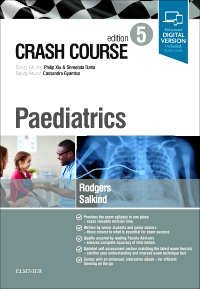
Crash Course Paediatrics Elsevier eBook on VitalSource, 5th Edition
Elsevier eBook on VitalSource

Now $33.24
Crash Course – your effective every-day study companion PLUS the perfect antidote for exam stress! Save time and be assured you have the essential information you need in one place to excel on your course and achieve exam success.
A winning formula now for over 20 years, each series volume has been fine-tuned and fully updated – with an improved full-colour layout tailored to make your life easier. Especially written by senior students or junior doctors – those who understand what is essential for exam success – with all information thoroughly checked and quality assured by expert Faculty Advisers, the result are books which exactly meet your needs and you know you can trust.
Each chapter guides you succinctly through the full range of curriculum topics, integrating clinical considerations with the relevant basic science and avoiding unnecessary or confusing detail. A range of text boxes help you get to the hints, tips and key points you need fast! A fully revised self-assessment section matching the latest exam formats is included to check your understanding and aid exam preparation. The accompanying enhanced, downloadable eBook completes this invaluable learning package.
Series volumes have been honed to meet the requirements of today’s medical students, although the range of other health students and professionals who need rapid access to the essentials of paediatrics will also love the unique approach of Crash Course. Whether you need to get out of a fix or aim for a distinction Crash Course is for you!
- Provides the exam syllabus in one place - saves valuable revision time
- Written by senior students and recent graduates - those closest to what is essential for exam success
- Quality assured by leading Faculty Advisors - ensures complete accuracy of information
- Features the ever popular 'Hints and Tips' boxes and other useful aide-mémoires - distilled wisdom from those in the know
- Updated self-assessment section matching the latest exam formats – confirm your understanding and improve exam technique fast
-
1 History and examinationPaediatric history takingAdolescent historyNeonatal historyPaediatric examinationThe neonatal examinationMedical sample clerkingFurther reading2 Investigations Urine testsBlood testsCerebrospinal fluidImagingFurther reading3 Cardiovascular systemCongenital heart diseaseRheumatic feverCardiac infectionsCardiac arrhythmiasFurther reading4 Respiratory systemPresentation of paediatric respiratory diseaseUpper respiratory tract infectionsLower respiratory tract infectionsAsthmaCystic fibrosisEars, nose and throatFurther reading5 Gastrointestinal and hepatobiliary systemsPresentation of gastrointestinal diseaseImportant gastrointestinal conditionsLiver diseaseFurther reading6 Renal and genitourinary conditions HaematuriaProteinuriaUrinary tract anomaliesUrinary tract infectionAcute nephritisNephrotic syndromeAcute kidney injuryChronic kidney diseaseGenital conditionsFurther reading7 Endocrine system and growthHypothalamus and the pituitary glandGrowthPubertyAdrenal disordersThyroid disordersDiabetes mellitusInborn errors of metabolismPolyendocrinopathiesFurther reading8 HaematologyHaematopoiesisAnaemiaHaemolytic anaemiaSplenomegalyBleeding disordersCoagulation disordersThrombotic disorders in childhoodFurther reading9 OncologyChildhood cancerThe leukaemiasLymphomasBrain tumoursNeuroblastomaWilms tumour (nephroblastoma)Soft-tissue sarcomasBone tumoursRetinoblastomaLangerhans cell histiocytosisFurther reading10 Fever, infectious diseases andimmunodeficiencyFeverViral infectionsBacterial infectionsParasitic infectionsImmunodeficiencyFurther reading11 Allergy and anaphylaxisEpidemiologyPathophysiologyAetiologyClinical aspects of allergyAnaphylaxisFurther reading12 Dermatology The child with a rashSpecific rashesSkin infectionsInfestationsFurther reading13 Nervous systemFits, faints and funny turnsThe unconscious childEpilepsyFebrile convulsionsHeadacheInfections of the central nervous systemMalformations of the central nervous systemCerebral palsyNeurocutaneous syndromesNeurodegenerative disorders of childhoodNeuromuscular disordersFurther reading14 Musculoskeletal systemLimpDisorders of the hip and kneeDisorders of the spineDisorders of the upper limbsDisorders of the skullFracturesBone and joint infectionsRheumatic disordersGenetic skeletal dysplasiasFurther reading15 The newbornMaternal and fetal healthFetal assessment and antenatal diagnosisMaternal conditions affecting the fetusNormal neonatal anatomy and physiologyBirthBirth injuryThe newbornDisorders of the term infantThe preterm infantDisorders of the preterm infantCongenital malformationsFurther reading16 GeneticsBasic geneticsSingle-gene disordersAutosomal dominant disordersAutosomal recessive disordersX-linked disordersMultifactorial disordersChromosomal disordersMitochondrial inheritanceGenetic counselling17 Developmental assessment anddevelopmental dayHistoryExaminationSigns of abnormal developmentFurther reading18 Child and adolescent mental healthAttachmentProblems of early childhoodAutism spectrum disordersAttention deficit hyperactivity disorderBehavioural problemsContinence problemsAffective disordersAnxietyPsychosisEating disordersMedically unexplained physical symptomsFurther reading19 Community paediatrics, public health and childprotectionPrevention in child healthChildren with disabilitiesChild protectionChildren and the lawFurther reading20 Accidents and emergencies EmergenciesAccidentsFurther reading21 Nutrition, fluids and prescribing NutritionFluids and electrolytesPaediatric pharmacology and prescribingFurther reading

 as described in our
as described in our 